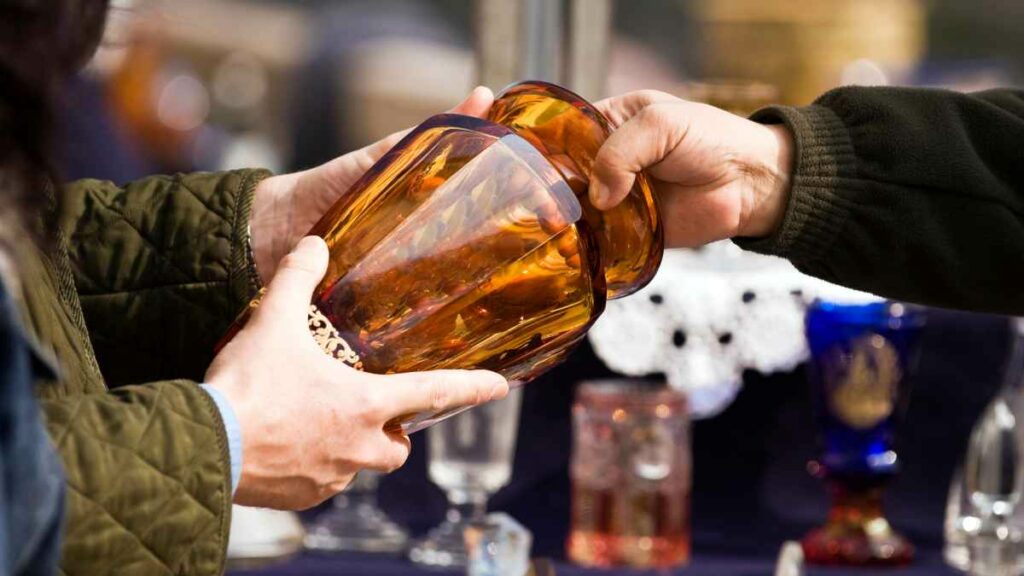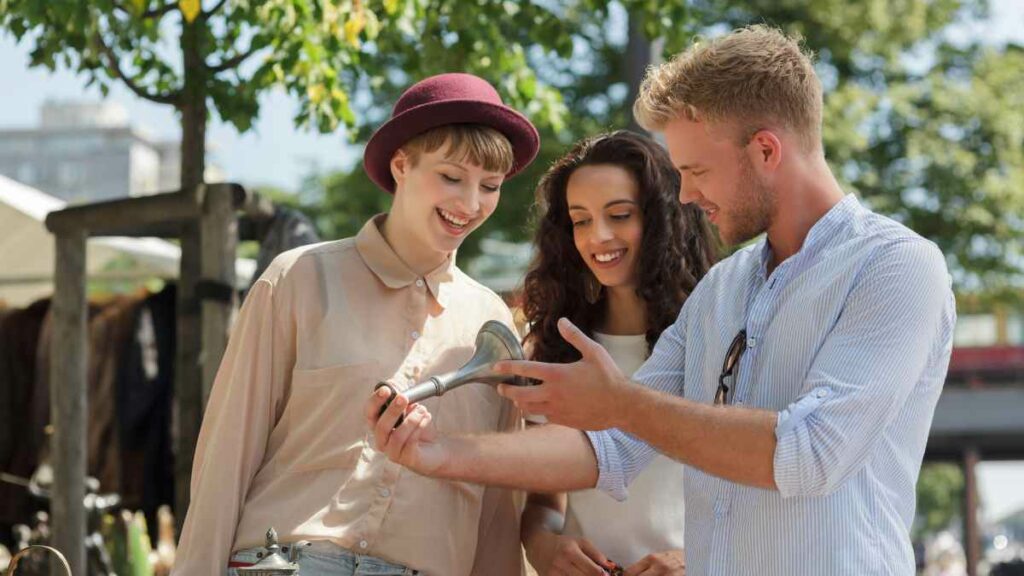Are you ready to dive into the bustling world of flea markets where every booth holds a story and every item has a history? Well, you have come to the right place. Today, we will discuss an age-old tradition that is as much a part of the flea market experience as the treasures themselves. Learn more about how to haggle at a flea market.

I know what you might think—bargaining with vendors sounds daunting, right? But trust me, with a few insider tips and a sprinkle of confidence; you will be haggling like a pro in no time, and yes, even snagging those deals that’ll make your friends green with envy.
We’ll walk through the dos and don’ts together, share a laugh or two about common pitfalls, and I’ll share some personal anecdotes that’ll have you going from a shy browser to a savvy negotiator faster than you can say “deal.”
So, grab your most comfortable shoes a cup of your favorite beverage, and let’s get started on mastering the art of haggling at flea markets. It’s all about having fun, connecting with the community, and saving a few bucks while you’re at it.
Ready to unlock the secrets? Let’s turn that “maybe…” into an “absolutely, let’s make a deal!”
Haggling Etiquette
Approaching Vendors with Price Proposals
It is all about the approach when you spot something that catches your eye. Start with a smile and a friendly greeting—it is not just polite; it sets the tone for a positive interaction.

Take a moment to express genuine interest in the item. Ask questions. Where did it come from? How old is it? Asking questions shows respect for the vendor’s goods and builds rapport.
Now, when it is time to talk numbers, there is an art to it. Begin by asking the vendor for their best price. It is a simple and respectful way to open the negotiation.
When you counteroffer, be reasonable. Offering too low can be off-putting, so aim for a fair price but leave room for the vendor to come down a bit.
Remember, the goal is a happy compromise where you and the vendor feel satisfied.
Understanding the Vendor’s Perspective
To truly excel in haggling, put yourself in the vendor’s shoes. They are here to make a living, and every item has its worth. Recognize that while you want a good deal, they deserve a fair exchange for their treasures. They may have personal attachments or have tried to restore what they are selling.
Respect their expertise and experience. Listen to the vendor attentively if they give you a backstory about the item’s value. It’s not just about making a sale; it’s about passing on a piece of history or craftsmanship. If a vendor seems firm on a price, it’s often for a reason. Ask them what makes the item unique—you might learn something fascinating.

Haggling is a conversation, not a competition. It’s a way to connect, learn the stories behind the items, and honor the transaction as more than just an exchange of goods—an exchange of value and respect.
Haggling Techniques
Language and Phrases That Work
The words you choose can make all the difference between a successful haggle and a flat-out no. Start with open-ended phrases and invite dialogue rather than demand a discount. For example, instead of saying, “Will you take $5 for this?” try, “Is there any flexibility on the price?” It’s less about the price point and more about starting a conversation.
When making a counteroffer, use phrases that show you value the item but are looking for a fair deal, like, “I love this piece, and I can see it’s worth a lot. Would you consider $X?” It’s also helpful to give a reason for your price—it doesn’t have to be elaborate; something as simple as, “I’m on a tight budget today” can work.

Vendors are more likely to respond positively if they feel you’re working towards a mutually satisfying deal. Using phrases like “What’s the best you can do?” or “Can we meet in the middle?” signals that you’re looking for a win-win situation.
Body Language and Presentation
Body language speaks volumes. Maintain friendly eye contact, but don’t stare down the vendor—that can be aggressive. Lean in slightly when discussing the item to show interest, but lean back when discussing the price to show you’re thinking it over.
A relaxed stance, with open palms and a genuine smile, can convey that you’re easy to work with. Nodding as the vendor speaks shows you’re listening and value their input. Avoid crossing your arms or appearing distracted—these can signal disinterest or disrespect.
Presentation-wise, consider how you’re dressed. If you’re decked out in high-end gear, a vendor might assume you can afford to pay the total price. Dressing down a bit can work in your favor, but keep it respectful. You’re part of a community at the flea market, and showing that through your demeanor and dress can help build the necessary rapport for successful haggling.

Knowing When to Walk Away
Recognizing a Good Deal
The key to mastering the art of haggling is not just about getting a lower price but also recognizing the value of what you’re getting. Sometimes, the vendor’s first offer might be the best you’ll get.
To know when you’re facing a good deal, do a quick mental check: Is the price fair compared to similar items you’ve seen? Does the quality justify the cost? Have you factored in the uniqueness or the history of the item?
You can also gauge the deal by the vendor’s reactions. If they agree too quickly to your low offer, it might be a sign to reevaluate—you may have undervalued the item.
Conversely, holding firm on their price after several counteroffers is likely a fair rate. Trust your instincts—if the deal feels right and you’ll regret walking away, it’s probably good.
The Power of Polite Refusal
There’s an undeniable strength in saying “no thank you” and mean it. Walking away is okay if the negotiation isn’t going in the right direction.
This isn’t just about the potential savings; it’s also about ensuring you’re genuinely happy with the exchange.
Before you walk away, a polite refusal can sometimes lead to a better offer. A simple “I’ll have to think about it” gives you an out while leaving the door open for the vendor to call you back with a lower price.
Being gracious is essential if they don’t and you’re uncomfortable with the cost. Thank the vendor and let them know you appreciate their time.
This maintains a positive relationship for future interactions—you never know when you might return for another item or run into it at another market.
Walking away isn’t a defeat; it’s a strategic move and sometimes even a negotiation tactic. Plenty can be found at the flea market, and the next great deal could be just a few stalls down.
Cultivating Confidence in Haggling through Practice and Respect
As we wrap up our journey through the art of haggling, remember that every market day is a new opportunity to hone your skills.
Haggling is a craft that gets better with practice, patience, and, yes, a bit of pluck. The more you engage with vendors, negotiate, and observe outcomes, the more adept you’ll become at recognizing the rhythm and flow of a good bargain.

But let’s not forget what makes haggling such a particular part of the flea market experience—the human connection. Every interaction is a mutual exploration of worth and value, underscored by a shared respect for the stories that every item in the market holds.
When you haggle, you’re not just negotiating a price; you’re participating in a tradition that dates back centuries, a dance of commerce that’s as much about people as it is about their wares.
So, stand tall with your newfound knowledge the next time you find yourself at a flea market. Approach each stall with a friendly smile, armed with the understanding that you and the vendor are crafting a story together—a story where both of you walk away feeling a little richer, not just in terms of the deal struck but in the shared experience of trade and trust.
Encourage yourself to step out of your comfort zone, try new phrases, and read the non-verbal cues.
With each step, your confidence will grow in your ability to haggle and your capacity to connect with the community around you.
And if a deal doesn’t go your way? Tip your hat, offer a smile, and move on—there’s always another deal waiting just around the corner, ripe for the making.
In the end, haggling is about finding balance—the joy of the hunt, the thrill of the deal, and the satisfaction of a respectful negotiation. Keep these elements in harmony, and you’ll walk away with great finds and the wonderful feeling of being part of the vibrant tapestry that makes flea markets so enchanting.



